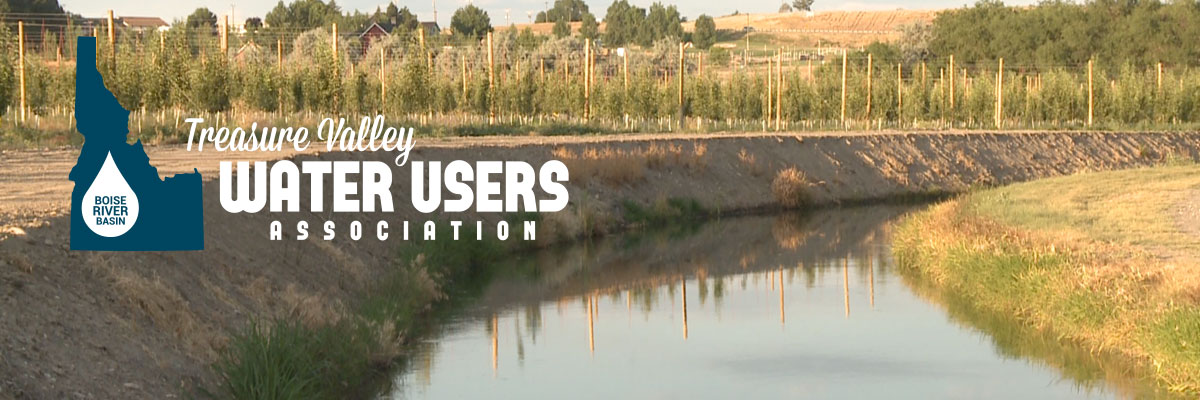

Release For Immediate Use – April 18, 2017
Contact: Roger Batt: (208) 412-5760 or (208) 888-0988
Near-record river flow levels are causing flooding that will cost homeowners and local governments enormous financial losses. At the same time we are watching massive amounts of water being sent down river that could be stored to help reduce flooding and also increase the capacity of irrigation water supplies to help meet the future needs of Treasure Valley residents. It’s a double whammy that spotlights the urgent need to seriously consider increasing our water storage capacity on the Boise River system, officials with the Treasure Valley Water Users Association say.
“Our reservoirs play a critical role in the reduction of flooding as well as providing irrigation storage. If we didn’t have them the situation would be a whole lot worse because the river would flow at uncontrollable levels and result in catastrophic flooding and devastating economic loss to the Boise Valley and its residents,” said Alan Newbill, Chairman of the Board for Pioneer Irrigation District. “If we had more storage capacity (more areas to store additional water) we could reduce flooding even more in our Valley. It would certainly benefit those residents who are being impacted right now.”
As of today officials have been forced to dump more than 750,000 acre feet of water down the river and out of Idaho to make room in the reservoirs for the rest of the snowmelt still left in the high country. That also translates into a significant loss of potential irrigation water that equals about 75 percent of the total storage capacity of our reservoirs.
Many in the Treasure Valley water user community are saying this year’s flood control crisis starkly illustrates that it’s time to stop talking and studying the issue of increased storage in the Treasure Valley and instead do something about it.
“We have talked about additional storage for years and gotten nowhere,” said Roger Batt, Executive Director for the TVWUA. “Historically seven out of every ten years are years where flood control is needed. This year’s flooding crisis, coupled with the demand for more water to meet the future needs of a rapidly growing area, is proof that we need to actually make it happen. We simply cannot afford to continue this ‘no action – talk only’ approach,” Batt added. “As you watch the current historic high flood flows on the river you are seeing water that is being wasted because it cannot be stored for future use. It’s water going down river never to be seen again. It is time for government, industry and citizens of the Treasure Valley to address once and for all the critical need for additional water storage in the Treasure Valley. You only need to look at what’s happening now to conclude that we simply cannot afford to continue to wait any longer,” Batt said.
A 2016 analysis by the Idaho Water Resource Board says the annual water demand for the Treasure Valley will increase by almost 200,000 acre feet by the year 2065 due to a population projected to jump by approximately 250 percent to 1.57 million people.
The combined storage capacity of the Boise River Basin’s three reservoirs can hold about one million acre-feet – but that’s only 25 percent of the total amount of water that is capable of passing through them. In years like this one about 3 million acre feet of water will be lost down the river and out of the state that could be stored for rural and urban irrigation purposes.
More of that lost water could be saved for use in the Treasure Valley through a variety of actions such as adding height to the existing dams or creating additional off-stream storage sites – similar to that of Lake Lowell – that could be used to store water diverted from the Boise River.
A variety of government studies have shown that raising the height of existing dams such as Arrowrock could annually create hundreds-of-thousands of additional acre feet of water available for local use.
Another option that has been studied extensively is the creation of new reservoir storage facilities such as the Twin Springs Dam on the North Fork of the Boise. Planners say that project alone could add more than 300,000 acre feet of extra storage capacity.
“It could make a huge difference in the amount of flood protection provided to area residents if water managers could remove an additional 300,000 acre feet of flood water from the river during high water times like we are experiencing now,” said Kenny Cole, Director for the Boise-Kuna Irrigation District. “The stored water then could be used to assist in recreation, municipal, commercial irrigation, and other uses during the long hot summer months.”
The Treasure Valley Water Users Association is a regional organization developed to address the need for coordinated collaboration among water delivery entities for the mutual benefit of their respective water users within the Boise River Basin. Its members operate irrigation delivery systems containing approximately 1,500 miles of canals and laterals that provide irrigation water to almost 400,000 acres of land from Boise to Parma including farms, ranches, residential sub-divisions, cities, parks, golf courses, schools, businesses and other sources.
-end-